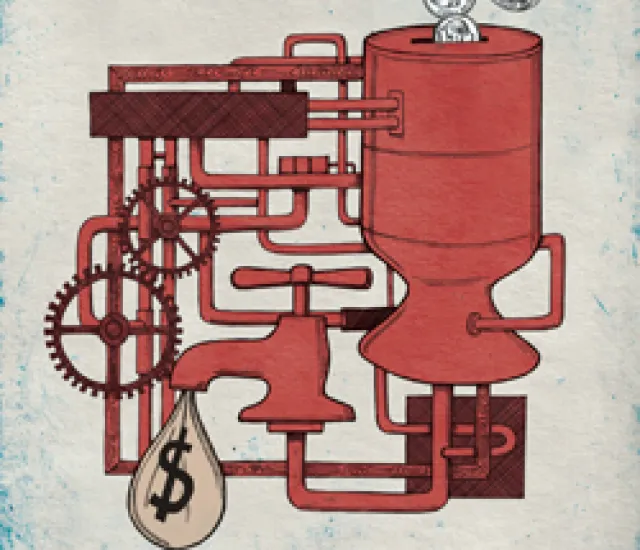What do a rice farm in Tanzania, a Native American community development bank in Montana and a low-income housing project in Newark, New Jersey, have in common? They’re part of the newest and perhaps fastest-growing asset class in institutional investing: impact investments. Designed to create a positive social impact and produce a financial return, these investments range from sustainable energy projects to microfinance and water treatment.
The impact investing market is relatively small, but JPMorgan Chase & Co. sees a rosy future. The bank predicts that capital invested in the sector will grow to between $400 billion and $1 trillion over the next ten years; however, former head of research Nick O’Donohoe says that estimate extrapolates from the 1,000 existing impact investing deals.
Impact investing, a concept developed in the late 1990s by Rockefeller Foundation managing director Antony Bugg-Levine, is distinct from the more-established concept of socially responsible investing, which is mainly concerned with excluding investments in controversial industries like weapons or tobacco.
Bugg-Levine says impact investing tackles tasks once left to philanthropy, using the techniques of private capital. “We cannot create the world we want to see with philanthropy alone, but neither can we rely on markets alone to address all the world’s social problems,” explains the former McKinsey & Co. consultant, who now heads the Harnessing the Power of Impact Investing initiative at the $3 billion, New York–based Rockefeller Foundation. “What really excited us about impact investing is the potential to unlock private capital as well as the creativity of the private sector.”
With charitable donations by high-net-worth individuals down 35 percent last year, according to Bank of America Merrill Lynch and Indiana University, impact investing raises questions about the wisdom of introducing the profit motive to a world that never previously had to justify its bottom line. Will low-cost housing always be low-cost if investors are trying to maximize profits?
As impact investing gathers pace, it uses many approaches. Adam Wolfensohn, son of former World Bank president James Wolfensohn, runs impact investing at his father’s New York firm. Although the term “impact investing” is a useful umbrella, he says, the organizations it covers are radically different. “They are unified by an awareness of the power of investment to solve social and environmental issues, but underneath that is an extraordinarily heterogeneous bunch, all doing worthy things in different ways,” explains the Wolfensohn & Co. managing director.
The main difference is whether investors put a bigger emphasis on profit or on social good. Institutional investors tend to be most concerned about returns, followed closely by the safety of their money in what is often an opaque investing environment.
New York–based TIAA-CREF has committed about $650 million to impact investing, but most of that is in low-income housing, with smaller allocations to microfinance, community bank deposits and green building technology. Scott Budde, head of social community investing at the $453 billion pension giant, says government pension rules oblige him to find investments with risk-adjusted returns comparable to those of mainstream opportunities. But, he adds, client surveys show that after risk and return, social investing is a high priority.
Prudential is another major player. The Newark, New Jersey–based insurer has about $400 million worth of impact investments, according to Preston Pinkett III, head of its social investment program. Although some of Prudential’s impact investments offer what Pinkett calls “a reasonable rate of return,” others put social outcome ahead of profit. “To get the impact we want, we’ve got to take on more risks than the returns we’re being offered would indicate in the financial analysis,” he says.
Before impact investing had a name, a number of foundations were striving to earn a decent return on their money while also doing good. One pioneer is the Palo Alto, California–based Skoll Foundation, launched in 1999 by Jeffrey Skoll, the first president of eBay. Set up to invest the foundation’s billion-dollar portfolio, Palo Alto’s Capricorn Investment Group has expanded to other foundations as well as high-net-worth individuals; it now manages about $4 billion.
Capricorn managing principal Ion Yadigaroglu says 10 percent of the firm’s assets are in direct impact investments. Capricorn also invests in companies that could be considered socially beneficial — solar power producers, for instance — but yield higher-than-expected returns. Yadigaroglu says the firm seeks investments with new and significant approaches to dealing with social questions. For example, Capricorn runs a Tanzanian rice farm with a program that helps local farmers become better entrepreneurs. “Every investment we make we think is an outstanding investment from a financial return perspective, but we are willing to question convention or go into areas other firms wouldn’t do,” Yadigaroglu says.
The Rockefeller Foundation’s Bugg-Levine reckons the next wave of capital will come from private banks and family offices looking to combine diversification opportunities with the possibility of helping others. UBS, for one, has set up a “values-based investing” unit at its Zurich-based private bank to serve clients worldwide.
Impact investing presents challenges to institutions used to dealing with established companies and funds. One question is how to compare the social benefits of investing in, say, solar power and microfinance. In response, a New York–based nonprofit called the Global Impact Investing Network has compiled a list of 399 metrics that a company can use to report impacts such as its customers’ poverty level; investors can compare various companies by requesting their metrics from GIIN. A similar project for institutional investors is the Global Impact Investing Rating System, which attempts to rate companies’ social and environmental impacts much like Standard & Poor’s rates credit risk.
What’s still unclear is how impact investors can ensure that their appetite for return doesn’t overtake their desire to improve the world. Recent reports of huge profits in the microfinance industry in India, with poverty-stricken borrowers allegedly abused by lending firms while investors earned huge profits, have raised some eyebrows. “We absolutely believe that impact investing must be a complement to philanthropy, not replace it,” Bugg-Levine says.






